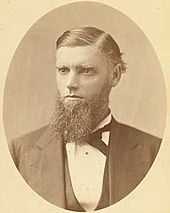William B. Mitchell
| William B. Mitchell | |
|---|---|
 | |
| Associate Justice of the Minnesota Supreme Court | |
| In office 1881–1899 | |
| Appointed by | John S. Pillsbury |
| Preceded by | F.R.E. Cornell |
| Succeeded by | Calvin L. Brown |
| Member of the Minnesota House of Representatives for the 11th Legislative District | |
| In office 1859–1860 | |
| Personal details | |
| Born | 19 November 1832 Niagara Falls, Ontario |
| Died | 21 August 1900 Minnesota |
| Nationality | American Canadian |
| Children | William D. Mitchell |
William Mitchell (19 November 1832 - 21 August 1900) was a distinguished American lawyer and judge from Minnesota. He was the namesake of William Mitchell College of Law and father of William DeWitt Mitchell, U.S. Attorney General during the Hoover Administration.[1]
Early life

Mitchell was born to Scottish immigrants in Ontario, Canada near Niagara Falls, New York. He attended Jefferson College in Cannonsburg, Pennsylvania and graduated in 1853. In school, he befriended Eugene Wilson, a native of Morgantown, in present-day West Virginia. Wilson convinced Mitchell to return with him and study law under Wilson's father after graduation. Four years later, they completed their schooling and were admitted to the Virginia Bar. Instead of remaining in Virginia, however, the two headed west, settling in the city of Winona, then in the Territory of Minnesota. Over the next seventeen years, Mitchell served as a city council member, bank president, member of the Minnesota House of Representatives, and head of a newly incorporated railroad company. The latter position served him well in his judicial tenure, as the rapidly expanding borders of the United States brought accompanying changes in its corporate and commercial laws.
Judicial career

In 1874, Mitchell was appointed to a judgeship in Minnesota's Third Judicial District. In 1881, he was appointed to the Minnesota Supreme Court. In his eighteen years on the court, he wrote more than 1,500 opinions, making huge contributions to the state's jurisprudence on issues such as negligence, state constitutional law and the common law of riparian rights and navigable waters. At one point, President Benjamin Harrison nominated Mitchell for an open seat on the Eighth Circuit Court of Appeals, but he eventually withdrew from consideration. Mitchell won bipartisan support in the judicial elections of 1886 and 1892, but failed to win the Republican Party's nomination in 1898 and left the supreme court the following year. After it was incorporated into the U.S. as a protectorate, Mitchell was offered the position of Chief Justice of Puerto Rico. He turned it down. Instead, he was selected as the first Dean of the law school that would bear his name, William Mitchell College of Law (then the St. Paul College of Law), but he died from a stroke before taking the position.
Reputation
Mitchell enjoyed a reputation as a great jurist in his day. He was well regarded in Minnesota and the country. In a letter to a friend in Minnesota, renowned Harvard Law Professor James Bradley Thayer wrote:
I have long recognized Judge Mitchell as one of the best judges in this country, and have come to know also the opinion held of him by lawyers competent to pass on an opinion on such a question . . . Pray do not allow your state to lose the services of such a man. To keep him on the bench is a service not merely to Minnesota, but to the whole country and to the law. Your state it is that is now on trial before the country. The question is: Can Minnesota appreciate such a man? Is it worthy to have him? I am not going to believe that a state which can command the services of one of the few judges in the country that stand out among their fellows as pre-eminent, that give it distinction, will refuse to accept these services.
Mitchell was also included in the two-volume Great American Judges, a biographical compendium of the one hundred greatest state and federal judges in American history.
Notes and explanations
- ↑ http://www.leg.state.mn.us/legdb/fulldetail.asp?ID=14009
- ↑ http://www.jamesmadisoncenter.org/Documents/Cert.apdx.pdf
| ||||||||||
|